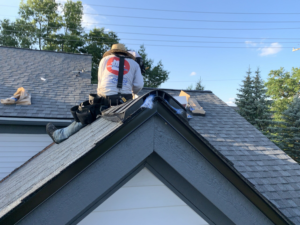Erie Metal Roof offers a wide range of advantages, including durability, long lifespan, and comprehensive warranties. They also add to property value.
The material used will dictate the overall cost. Copper, for example, is a premium option known for its non-corrosive properties and elegant aging process. However, it is more costly than steel.

A metal roof can last for decades and outlast traditional roofing materials, reducing replacement costs for property owners. With minimal maintenance, metal roofs can extend their lifespan and provide protection against extreme weather conditions that would quickly damage shingles or other roofing materials. Depending on the type of metal and coatings used, a metal roof can resist rust and other weather conditions that would otherwise compromise its durability.
Metal roofs are the ideal roofing material for areas that experience frequent severe weather conditions like hurricanes and tornadoes. Their strength and resilience protects against gusts of wind up to 140 mph, preventing damage to buildings and other structures and potentially saving homeowners insurance premiums. They also offer superior rust resistance, making them less likely to corrode over time.
With proper installation and regular inspection, a metal roof can last for over 50 years, significantly longer than most other roofing options. Regardless of the roofing material chosen, however, the lifespan of your roof can depend on its general condition and your specific environment.
Some common issues that can affect the longevity of a metal roof include:
Inconsistent color matching. This is especially important if you decide to repair a section of your roof or add on an extension years after the initial roof was installed, as it can be challenging to match the exact color of the new sections to the existing metal panels.
Corrosion and other damage to metal roofs are typically caused by natural wear and tear, rather than environmental factors. However, corrosion and other damage can be minimized by choosing a durable metal roof and performing routine inspections.
Other common problems with metal roofs are scratches and dents. These can occur when tree branches and shrubs rub against the panels during strong winds. By regularly trimming trees and bushes around the roof, these issues can be prevented.
Other common issues that can decrease the lifespan of a metal roof are exposed fasteners and loose screws. By ensuring that all fasteners and connectors are tightened and sealed, these problems can be avoided. In addition, ensuring that the screws and washers are made of a high-quality metal can help them last longer, as they’re more resistant to wear and tear.
Aesthetics
The sleek, contemporary appearance of a metal roof can instantly transform the overall look and feel of a home or commercial structure. The wide array of colors, finishes, and textures available ensures that any design preference can be accommodated. This flexibility in aesthetics allows architects, designers, and building owners to create structures that both function well and elevate the beauty of a property.
A metal roof’s unique profile and manufacturing process allow it to offer a range of aesthetic options that other roofing materials cannot match. Corrugated panels, for example, can take on a sturdier and more traditional look, while standing seam metal roofs are known for their clean lines. For homeowners who are drawn to more natural aesthetics, the option of a metal shingle that closely resembles slate or clay tiles is also available.
Choosing the right color is just as important as the type of metal roof you choose. In addition to classic metallic hues like silver and bronze, there is a wide selection of paints and coatings that provide a variety of aesthetic looks. These choices can help to reduce cooling costs, improve energy efficiency, and coordinate with other architectural features of a home or commercial space.
Another important consideration is the durability of a metal roof’s finish. A durable coating is vital for protecting your investment, especially if you live in an area with harsh weather conditions. Metal roofs can be treated with coatings that resist fading and chalking, providing years of protection and vibrant beauty.
Finally, a metal roof’s ability to reflect sunlight enhances the natural beauty of a property. From the lush greenery of spring to the golden hues of autumn, a metal roof’s reflective properties make for a beautiful visual experience. This unique attribute can significantly increase a home or business’s curb appeal and bolster its value in the real estate market.
A personalized metal roof reflects a homeowner’s design preferences and personality, increasing its value in the real estate market and boosting its curb appeal. Working closely with skilled professionals throughout the McMurray, PA area, homeowners can ensure that their vision for a new roof comes to life exactly as they imagined.
Energy Efficiency
A metal roof saves you money on your energy bills by reflecting the sun’s rays rather than absorbing them. This helps keep the home or building cool during the hot Miami summers, reducing the need for air conditioning. In fact, a well-installed metal roof can cut cooling costs by up to 40 percent.
The roof color you choose is another factor that impacts energy efficiency. Light colors work the best for reflectivity, but even dark roofs can lower your energy costs as long as they are painted with a reflective coating. The company that installs your metal roof will be able to recommend the best options.
Most metal roofing panels come in a range of finishes that are energy efficient, but some are more efficient than others. The color you select should match the other features of your house, including the stucco, siding or brick. It is also important to consider the other colors of nearby buildings and environmental features such as trees and bushes.
Insulation can make a significant difference in the energy efficiency of a metal roof. Ideally, it should be installed before the metal panels are placed on the roof. Rigid foam, spray insulation and fiberglass batt insulation are all effective products for insulating metal roofs.
Another way a metal roof reduces energy costs is by keeping the cold air in during the winter. During the winter, a well-installed metal roofing system can keep your home or business warm with its reflective properties while allowing natural air to circulate in the attic.
When compared to shingle roofs, metal roofs are more energy efficient. The reflectivity of metal roofs allows heat to pass over the surface and vent out into the atmosphere, while shingle roofs absorb heat and release it slowly.
Another advantage of a metal roof is its fire-resistant properties, which can significantly improve your home’s resale value. In addition, a metal roof is environmentally friendly, as it is 25-95% recycled and 100% recyclable at the end of its life as a roof. This is in contrast to shingles, which are usually landfilled or added to the waste stream as construction debris.
Recyclability
If going green is one of your resolutions, then you will be happy to know that metal roofs offer a number of environmental benefits. For example, they are energy efficient and they are crafted from a high percentage of recycled materials. These factors make them a great option for those looking to achieve LEED certification on their new construction or renovation project. This is because LEED certification gives builders and architects points for using products with a high recycled content. Metal roofs are made from a variety of metals including copper, zinc, aluminum and steel. When selecting a metal roof, be sure to ask your contractor if they use pre-consumer or post-consumer recycled materials in their construction. Pre-consumer recycled material is scrap metal that is recovered from the manufacturing process. Post-consumer recycled metal is used in products that have already been purchased by consumers such as cans, appliances and beyond.
Once a metal roof is ready to be recycled, it can easily be turned into new roofing panels. The recyclability of metal roofing is important because it reduces the need to extract raw materials and helps to preserve landfill space. It also helps to lower energy consumption and cuts down on carbon emissions.
When a metal roof is recycled, it is first sorted by its base qualities. This is done to ensure that it will be able to be processed properly for reuse. It is then crushed into a block and transported to different mills to be melted down and reformed into new products.
The most common metals that are recycled include aluminum, copper and zinc. These metals are commonly found in the construction industry due to their versatility and durability. These recycled metals are then incorporated into new building materials like roofing, wall panels and more.
When you are ready to recycle your metal roof, it is crucial to ensure that all non-metal contaminants are removed from the panels before handing them off for recycling. This includes tar, wood and other non-metallic materials that can interfere with the recycling process. It is also important to assess the physical condition of the metal sheets to ensure that they are free from severe corrosion or structural damage. This will make the recycling process easier and more efficient for both the metal yard and the processing plant.





